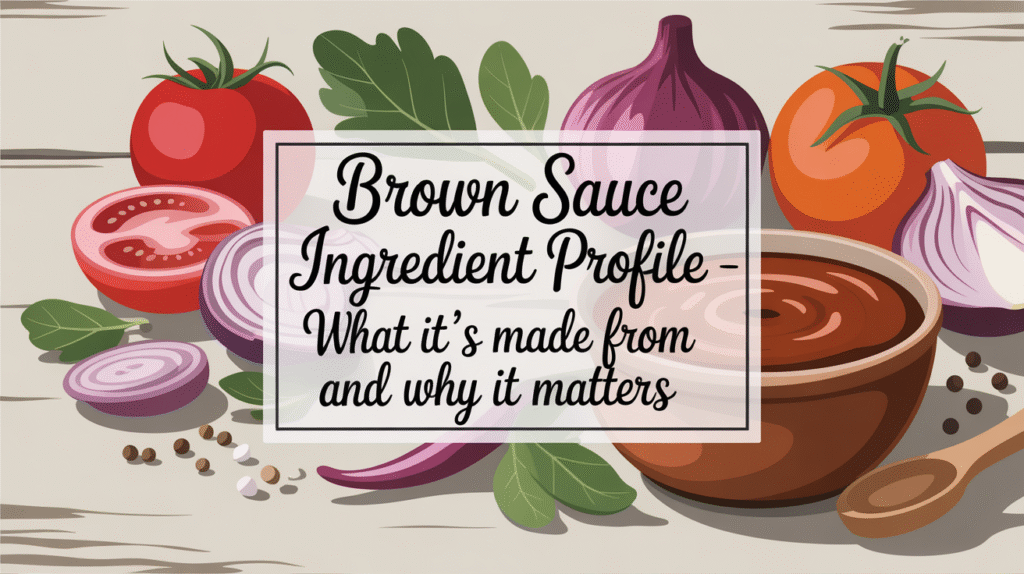Affiliate Disclosure: PantryBrands.co.uk is a participant in the Amazon.co.uk Associates Programme. As an Amazon Associate, we earn from qualifying purchases made through links on this site.
Brown sauce is typically made from tomatoes, vinegar, dates, molasses, and a mix of spices that create its signature tangy, sweet, and savoury flavour. While brands vary, the core ingredients follow a consistent profile rooted in British culinary tradition. Understanding what goes into brown sauce not only helps you choose the right one but also allows you to make informed decisions about flavour, nutrition, and usage.

In this article, we break down the most common ingredients found in brown sauce, how they affect the taste, and what to look for on the label.
Core Ingredients in Traditional Brown Sauce
Most brown sauces in the UK share a familiar set of base ingredients that give them their characteristic profile.
Tomatoes
Tomatoes form the base of many brown sauces, though in smaller quantities than ketchup.
- Provide acidity and a mild sweetness
- Contribute to the sauce’s thickness and umami flavour
Tomatoes also balance out the stronger ingredients like vinegar and spices.
Vinegar
Usually malt vinegar, this is one of the key flavouring agents in brown sauce.
- Offers tang and sharpness
- Acts as a natural preservative
Vinegar cuts through rich foods and adds depth to the overall profile.
Sweeteners
Brown sauces are known for their sweet-tangy contrast, achieved with natural and added sugars.
- Common sweeteners include molasses, brown sugar, and glucose syrup
- Dried fruits like dates, raisins, or prunes add natural sweetness
Molasses, in particular, gives the sauce its dark colour and rich body.
Fruits and Dried Fruits
A blend of fruits helps round out the flavour and add complexity.
- Dates and raisins add natural sugar and thickness
- Apples, tamarind, or sultanas may be included for added body and a fruity finish
These fruits also help create a sticky consistency that clings well to food.
Spices and Seasonings
Spices play a crucial role in giving brown sauce its distinctive warmth.
- Typical spices include black pepper, allspice, cloves, and ginger
- Onion and garlic powders are also common for a savoury edge
Some brands include mustard powder or paprika for added depth.
Salt and Preservatives
Salt enhances flavour and improves shelf life.
- Usually present in moderate to high amounts
- May be balanced with potassium-based salt alternatives in reduced-sodium versions
Preservatives such as citric acid or stabilisers may also be used, especially in mass-market brands.
Ingredient Differences Between Brands
Each brand uses the above ingredients in varying proportions, resulting in noticeable differences in taste and texture.
HP Sauce
- Contains malt vinegar, dates, tamarind, and a distinct spice blend
- Strong and tangy with a thicker texture
HP Sauce is considered the benchmark for traditional brown sauce.
Daddies Sauce
- Uses a milder spice mix and less vinegar
- Sweeter and slightly smoother in texture
Often preferred by those looking for a softer flavour profile.
Branston Brown Sauce
- Known for its fruit-forward, chutney-like quality
- Chunkier texture and richer, sweeter flavour
Best suited for those who enjoy strong, punchy condiments.
Artisan and Gourmet Brands
- May feature balsamic vinegar, apple purée, or spiced rum
- Often omit preservatives and use organic ingredients
These sauces usually offer a more natural taste and varied textures.
Why Each Ingredient Matters
Each component of brown sauce contributes to more than just taste.
Functional Benefits
The ingredients in brown sauce serve both flavour and functional purposes:
- Vinegar and salt preserve the sauce naturally
- Sugar and molasses improve viscosity and colour
- Spices and fruit layer in depth and warmth
The final result is a well-rounded condiment that enhances savoury dishes.
Nutritional Implications
Certain ingredients affect the health profile of brown sauce:
- Added sugars and glucose syrups increase calories and glycaemic impact
- High salt levels may concern those watching sodium intake
- Whole fruits like dates or raisins offer fibre and natural sweetness
Reading the label helps determine whether the sauce fits your dietary needs.
Ingredient Variations for Dietary Needs
With changing consumer preferences, many brands now cater to specific dietary requirements.
Low-Sugar and Sugar-Free Options
These typically reduce or eliminate added sugars:
- Use fruit purée or artificial sweeteners instead of glucose syrup
- Maintain flavour with added spices and vinegar
Helpful for diabetics or those on calorie-controlled diets.
Gluten-Free and Vegan Brown Sauces
Most brown sauces are naturally vegan, but some contain barley malt (gluten).
- Gluten-free versions replace malt vinegar with cider or white vinegar
- Vegan brands avoid anchovy extract or honey where used
Always check the label to ensure it meets your requirements.
Organic and Additive-Free Options
These sauces focus on natural ingredients and simpler formulations:
- Made in small batches with no artificial preservatives
- Often use organic fruit, vinegar, and spices
Ideal for clean eating or health-conscious consumers.
How Ingredient Balance Affects Taste
The overall balance between sweet, sour, and spicy ingredients determines how a brown sauce tastes.
Matching Flavour to Purpose
Some sauces are designed for robust, meaty dishes, while others are gentler for everyday use.
- High vinegar content – Best for cutting through fatty or fried foods
- Fruity sauces – Complement cold meats, cheeses, or vegetarian dishes
- Spicier blends – Ideal for bold meals like BBQ, burgers, or strong cheeses
Understanding the ingredient profile can help you choose the right sauce for every occasion.
FAQs About Brown Sauce Ingredient Profile
Here are some questions and answers about Brown Sauce Ingredient Profile to help you better understand what goes into your favourite condiment.
What is the main ingredient in brown sauce?
The main ingredients are typically tomatoes, vinegar, sugar or molasses, and a blend of spices and dried fruits like dates or raisins.
Is there a difference between ingredients in HP Sauce and other brands?
Yes, HP Sauce has a stronger vinegar and tamarind profile, while others like Daddies or Branston may use different spice blends or sweeteners.
Are all brown sauces vegan?
Most are vegan, but it’s important to check for ingredients like honey or anchovy extract in some specialty or imported versions.
What makes brown sauce brown?
The colour comes from a combination of molasses, caramelised sugar, and dark fruits like dates or prunes, often intensified by cooking.
Can I make my own brown sauce using these ingredients?
Yes, you can replicate brown sauce at home using tomatoes, vinegar, molasses, fruits, and spices. Homemade versions allow more control over taste and nutrition.
